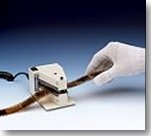mshchem
Subscriber
Prototype is handsome!
That’s because at the end of the day, it doesn’t change how you process it or change the white balance on a raw file.
Frankly, I don't care for WB. It's the ability to set gain independently to individual photosites. Now, I don't follow the digital camera scene, but that's easily got to be worth at least 1 stop in DR even for a largely ISO invariant sensor. Astrophotographers must've went gaga when this stuff was introduced, yet I can't find anything about it...
There's also this strange vertical noise / distortion issue that I intuitively don't understand yet so any suggestions on that are very welcome!
The lines likely is dust on your sensor, or a defective/unresponsive or miscalibrated sensel.
I assume you're talking about the staggered diagonals etc., and not the longitudinal lines? The latter I agree with @Adrian Bacon are probably due to something like dust. The former looks like a timing/synchronization issue between the film transport and the sensor sampling. It looks like you're sampling several times at the same position, then step a decent distance and then sample several times again.
Have you considered using a DC servo instead of a stepper? It has the advantages of being quieter and smaller, and probably cheaper.
Maybe the would work well with a gearbox.
- 3750 or 5400 dpi depending on the sensor chosen.
- Around 10 minutes scan time for colour.
- 14 bit ADCs.
Please follow the link below for the full resolution image, looks real nice.
This is quite impressive! An equivalent camera scanning setup would require a 39 megapixel camera (assuming 5400 dpi) with a 14 bit sensor.
Is the scan time for a single 35 mm frame?
Love this image. Well done!
That's really great news. Are you still considering an infrared pass or - let's dream - an implementation of ICE ? Are they even still licensing their technology ?
I wonder if a super simple and cost effective solution would be to use a film cleaner just before the scanning element.
I'm not sure yet. The sensors that are available have a BW channel with some IR sensitivity however I'm not sure if that'll work. There are few sensors on the market and the ones that are are limited. I've been doing my tests with a roll of film that's just been sitting on my desk, I give it a quick wipe before a scan and get very little dust. I wonder if a super simple and cost effective solution would be to use a film cleaner just before the scanning element. This is still an area of unknown and requires a fair amount of work.
I wonder if a super simple and cost effective solution would be to use a film cleaner just before the scanning element. This is still an area of unknown and requires a fair amount of work.
I wonder if a super simple and cost effective solution would be to use a film cleaner just before the scanning element. This is still an area of unknown and requires a fair amount of work.
Dust is like genes, some get a lucky draw, some don't. My place is filled from top to bottom with dust. I'd spend hours with the stamp tool in Lightroom if it wasn't for ICE.
I wonder if a super simple and cost effective solution would be to use a film cleaner just before the scanning element.

| Photrio.com contains affiliate links to products. We may receive a commission for purchases made through these links. To read our full affiliate disclosure statement please click Here. |
PHOTRIO PARTNERS EQUALLY FUNDING OUR COMMUNITY:  |